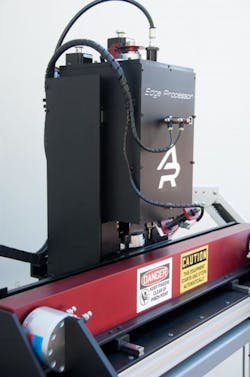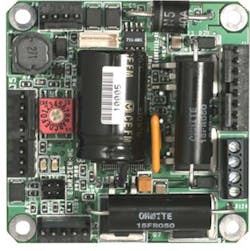One consulting and manufacturing firm built an edge-processing machine as a first step in letting it more easily build robotics for the semiconductor industry.
Axis Robotics Inc., Orangevale, Calif., is a consulting firm that also does short-run manufacturing for semiconductor equipment. While prototyping a client’s tool, Axis engineers decided they needed a tool of their own — something to automate drilling and tapping on the edge of a plate.
“The manual process averaged five minutes per hole to get it marked, punched, drilled, tapped, and cleaned,” says Dave Kush, Chief Engineer at Axis.
Their new tool does it with greater accuracy and at only 30 sec per hole. The machine performs four different operations. Its ridged short drill, also called a peck drill, puts a v-shaped hole into the edge plate. A turret rotates to the next tool, and a standard drill puts ½ to ¾-in. deep holes into the plate. Once the holes are made, the turret repositions a tapping tool for threading them. Finally, a long needle-like nozzle blows tapping chips and coolant from the hole, readying the edge plate for finishing.
The edge processor in effect operates like a three-axis CNC machine — but for only one specific operation.
Three controllers from AllMotion, Union City, Calif., www.allmotion.com handle all the motion for three of the machine’s axes. One controller operates the rotation of the four-position turret whichhas four tools mounted at 90° offsets. The turret turns the selected tool into position for each operation. The controller for the X-axis slides equipment along a 33-in. rail to drill, tap, and clean the plate. A third AllMotion controller operates the Z-axis for drilling, tapping, and cleaning. This axis can move three in., but often only needs change position by 0.5 to 0.75 in. The machine’s Y-axis is manually adjustable to accurately position the drill at the centerline of the plate edge. The Y travel is enough to let the machine process plates up to one inch thick.
Axis Robotics chose to use AllMotion EZHR23ENHC controllers for all three operations, even though the machine is limited by the top speed of the drills and tapping tools, far below the AllMotion controller capabilities. So, there’s plenty of torque.
The EZHR23ENHC controllers work with stepper motors in myriad automation machines. They measure 2.25-in. square and each bolts onto the back of the stepper motors it controls — up to size-23 motors. A single four-wire bus links up to 16 controllers in a daisychain. Two wires carry power (12 to 40 V) and two transmit communications. Commands can be input from any serial-terminal program or from the EZStepper Windows application. Axis Robotics wrote its own software and downloaded the commands to the controllers through an RS485 link.
An on-board EEPROM is available for storing user programs. Each EZHR23ENHC can also work in standalone operation. On Axis Robotics’ hole-making machine, it executes a preset string of commands upon startup, including nested loops and execution halt pending a switch closure.



